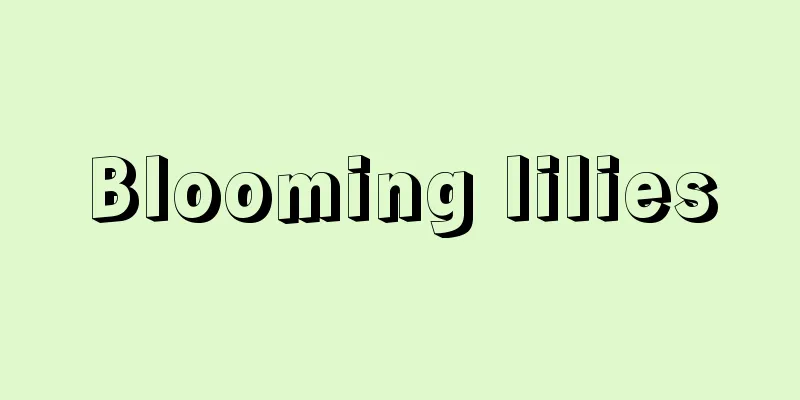Blooming lilies

Morphological characteristics of lilyLily is a perennial bulbous herb with a plant height of 40 to 60 cm, and some are over 1 meter tall. The stem is erect, unbranched, grass green, with red or purple-brown spots at the base of the stem. The leaves are simple, alternate, narrowly linear, without petioles, directly wrapped around the stem, with parallel veins. Some varieties produce purple or green granular bulbils between the leaf axils, which can be propagated into small plants. The flowers are borne at the top of the stem in a raceme, clustered or solitary, with a large corolla and a long, funnel-shaped, trumpet-shaped, six-lobed, and sepal-free. Because the stems are slender and the flowers are large, they often droop or stretch flat when open. The colors vary depending on the variety, mostly yellow, white, pink, orange-red, some have purple or black spots, and there are also flowers with multiple colors, which are extremely beautiful. Some of the petals are flat, while others are curled outwards, hence the beautiful name “Rolling Dandelion”. Some flowers have a strong fragrance, so they are called "musk lilies". The flowers fall and form oblong capsules. Growth habits of liliesLilies prefer cool and humid environments. Places with plenty of sunlight and slightly shady environments are more suitable for lilies. They avoid drought and extreme heat, and have slightly poor cold resistance. The growth and flowering temperature of lily is 16 ~ 24 ℃. Growth almost stops when the temperature is below 5 ℃ or above 30 ℃. The plant grows normally above 10 ℃. When the temperature exceeds 25 ℃, the growth stagnates again. If the night temperature in winter is below 5 ℃ for 5 to 7 days, flower bud differentiation and bud development will be seriously affected, delaying flowering and even causing blind flowers and flower cracks. Lilies prefer fertile, deep soil with a lot of humus, and are most afraid of hard clay; well-drained slightly acidic soil is preferred, with a soil pH of 5.5 to 6.5 . Distribution of liliesLilies are mainly distributed in temperate regions of the Northern Hemisphere, including eastern Asia, Europe, and North America. More than a hundred species have been discovered around the world. China is its main place of origin, with more than fifty species native to it, making it the natural distribution center of lily plants. What is the function of lilyOrnamental value: The main application value of lily lies in its ornamental value. Lily is known as the "Fairy in Clouds". Due to its elegant and pure appearance, the Catholic Church regards the lily as a symbol of Mary, while the Vatican regards the lily as a symbol of national independence and economic prosperity and makes it the national flower. The bulb of lily is made up of scales embraced together, which means "a happy marriage for a hundred years" and "everything goes well". Chinese people have regarded it as an indispensable auspicious flower in weddings since ancient times. Lilies have elegant flowers, green and beautiful leaves, and slender stems. They are a valuable new cut flower. Lilies can be used as focal flowers or framework flowers in flower arrangements. It is a special type of flower material. Edible value: The bulbs of lilies are rich in starch, and some varieties can be eaten as vegetables. The Chinese Lanzhou lily, which is famous for its edible value, was first recorded in the annals of Pingliang County, Gansu Province, more than 450 years ago. At present, edible lilies are widely planted in Qilihe, Lanzhou and other areas, and enjoy a high reputation both at home and abroad. Lanzhou lilies are large and sweet, and can be used as snacks or dishes. Lily soup made from Yixing Fritillaria is a great summer refresher. Lily can also be made into dried lily and lily powder, which have a very high price in the international market. Medicinal value: Lily is a commonly used medicinal material in traditional Chinese medicine. Traditional Chinese medicine believes that lily is slightly cold and neutral in nature, and has the effects of clearing heat, moistening the lungs, and calming the nerves. Its flowers and bulbous stems can be used as medicine, and it is a flower that can be used as both medicine and food. |
>>: Margarite flower cultivation methods and precautions
Recommend
How to propagate osmanthus trees by cuttings, pictures of osmanthus trees
1. Cutting time It is recommended to carry out it...
Is Houttuynia cordata the same as Houttuynia cordata? Can Houttuynia cordata be eaten?
1. Are they the same? Houttuynia cordata and Hout...
Grab a handful of “melon seed shells” and throw them into the soil. The soil will not become compacted and the leaves of the plants will grow vigorously!
Once the soil becomes compacted, the roots of the...
How to propagate star begonia
1. Seeding method Time selection: For this method...
When watering Kalanchoe, should I water the flower or the soil? What should I do if the stem turns black due to excessive watering?
1. Watering the flowers or the soil When watering...
Things to note when repotting vinca rosea: root pruning, watering, and maintenance are also important
Precautions for repotting Catharanthus roseus The...
How does Chlorophytum survive the winter?
1. Keep warm Chlorophytum is a common potted plan...
What should I do if the core of the peony flower turns black?
Reason 1: Lack of water Solution: Improve waterin...
What is Chunbulao?
What is Chunbulao? "Chunbulao" is a fam...
Hibiscus cultivation methods and precautions
Flower Pot Selection It is best to use unglazed p...
How to grow Gloxinia in winter
1. Winter maintenance methods 1. Remove the bulb ...
Is jasmine easy to grow?
Jasmine , known for its white flowers and rich fr...
Cultivation methods and precautions of duckweed
Soil selection for Nuphar The pH requirement of t...
Can evergreen be propagated by cuttings? In which month is it best to propagate by cuttings?
Can evergreen be propagated by cuttings? Wan Qing...
National first-class drought-resistant wheat variety, high-yield, cold-resistant and drought-resistant wheat seeds
Many wheat-growing areas have limited water condi...









